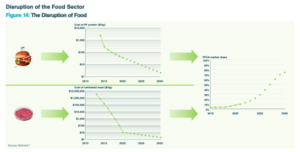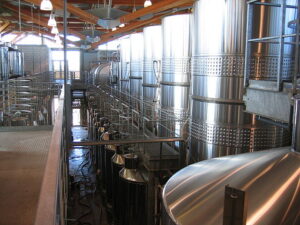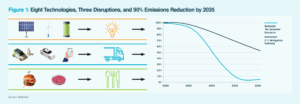According to RethinkX, precision fermentation and cellular agriculture will create an entirely new business model in the food sector: food-as-software. This will disrupt and transform our food and agricultural industries.
If major changes in a number of key technologies come together, we witness a disruption with possible major consequences for our society, according to RethinkX. Such a disruption comes near in five important sectors of our economies: information, food, transport, energy and materials. According to Tony Seba and James Arbib, founders of RethinkX.

Microorganisms
Precision fermentation (PF) is a transformative technology; it emerges within our food & agriculture sectors. It is based on modified microorganisms, able to produce almost any complex organic molecule. This technique has the potential to disrupt the food & agriculture industry entirely. RethinkX compares it to the domestication of plants and animals. This first domestication allowed us to master macro-organisms for our food. The second domestication will allow us to harness micro-organisms.
Fermentation is the process in which micro-organisms produce useful substances from raw organic materials. Precision fermentation as a special case can produce proteins, carbohydrates, fats and many other molecules found in dairy, meat, eggs, fish and even non-food products like fabric dyes and leather. This has unprecedented consequences. As RethinkX says, ‘for the first time in our history, the ceaseless exploitation of plants, animals and planet will no longer be necessary.’ We no longer need to mistreat animals to produce our food. With precision fermentation, we can in principle produce any food we would like. This discovery will change our relationship to the natural world. We can even solve the climate crisis, using this ability.

The disruptive effect of precision fermentation
Precision fermentation in short has the potential to disrupt the food and agriculture industry. Precision fermentation farms will become the new food farms. That will fundamentally change our relationship to nature. We do not have to use (exploit) plants and animals anymore. We don’t need to do them any harm, or break them down to the things we need. We just program microorganisms, in order for them to produce what we need. As RethinkX says: precision fermentation foods are not GMO. For they are made from proteins, and proteins contain no genetic material. ‘The DNA of a single soy plant or chicken will be enough to create an unlimited quantity of soy or chicken protein.’
Precision fermentation will shift our modes of food production: from a model of extraction to a model of creation. With it, we create the same goods, without the harm. For instance without animal suffering. Moreover, precision fermentation will not produce side products – often not useful to us, while causing environmental harm nevertheless. RethinkX foresees that the land currently used for animals (70% of agricultural land) will be freed. These are areas that can be reforested. Doing good for the climate.
Cheaper food
Precision fermentation has many valuable consequences. Foods produced in this way will be cheaper and superior to conventional food. Moreover, precision fermentation foods can be designed and manufactured anywhere in the world. This will democratize food production and eliminate geographic advantage.
And precision fermentation is just the beginning. It is now being combined with an entirely new model of production we call food-as-software. In this technology, we engineer individual molecules. Scientists will then uploaded the ‘recipes’ to databases. These databases are molecular cookbooks: food engineers anywhere in the world can use them to design products. In the same way that software developers design apps.
 Towards a localized system
Towards a localized system
This will have a profound effect. So far, our food system depended on scarce resources. It will now develop into ‘a localized, resilient system based on superabundant, creative production.’ As RethinkX states, this will make it easier to stabilize, localize and democratize food production. Moreover, it will minimize harm to our environment; and maximize delicious, nutritious and superabundant food for all. This will open up ‘a distributed, open-source, low-cost food system where entrepreneurs anywhere can design and produce foods with relatively low barriers to entry.’
No need to emphasize that this new technology will have a lasting impact. For instance, property rights and approval processes for new food products will have to be devised soon.
Poteins
In essence, the coming disruption will centre around proteins. Modern proteins will be cheaper than existing food options. As RethinkX prophesizes: ‘the cost of proteins will be five times cheaper than existing animal proteins by 2030, and 10 times cheaper by 2035. Eventually proteins will be nearly as cheap as sugar.’ Moreover, food can have an endless variety. It will be cheaper, as well as ‘more nutritious, healthier, better tasting and more convenient.’
The sector most affected will be animal farming. Modern food industries will produce the same substances as cattle farming, but cheaper and better tasting. Cattle farming industry will be under the threat of bankruptcy within a few years. Modern alternatives already started disrupting the meat market.
Cost parity
Once cost parity is reached, adoption will tip and accelerate exponentially. This is because the dairy sector is already balancing on a knife edge. Only a small percentage of the ingredients need to be replaced for the entire sector to be disrupted. For the dairy sector, RethinkX judges that proteins in the milk will be the essential ingredient. The substitution of these proteins might trigger a cascade of disruptions – overlapping, reinforcing and accelerating each other. That will in the end bring down the entire sector. Through a ‘death spiral of increasing prices, decreasing demand and reversing economies of scale.’ And long before modern technologies will be able to produce the perfect cellular steak.
The food disruption will free up much of the land used for animal agriculture – maybe a much as 80%. This will have a profound effect on climate. For even without active reforestation, the ‘passive reforestation’ will capture and store an equivalent of up to 20% of today’s global emissions.
Food-as-software
Eventually, these developments will produce a model that RethinkX calls food-as-software. This will entirely transform our food and agriculture industries. The result of scientific research will be published in ‘molecular cookbooks’. These describe food products in the same way that software developers design apps. In this model, recipes are improved constantly. ‘Each version superior and cheaper than the last.’ A completely decentralized system that will allow fermentation farms to be located in or close to towns and cities – where the customers are.
And remember: modern foods will be up to 100 times more land efficient, 10-25 times more feedstock efficient, 20 times more time efficient, and 10 times more water efficient. They will also produce less waste.
Localized food production systems
Therefore, food-as-software will result in localized food production systems, far more stable and resilient than our current model. These will much less be influenced by volume and price volatility; caused by variations in seasons, weather, drought, disease and other natural, economic and political factors. Moreover, geography will no longer offer a competitive advantage. Food-as-software can be used anywhere in the world. We will therefore ‘move from a centralized food system dependent on scarce resources, to a distributed system based on abundant resources.’ Such a system will even have effects on other sectors, like ‘healthcare, cosmetics and material production.’
In short, we are on the cusp of a revolution in our food production system. Not just the way in which we produce our food will change fundamentally; this will also affect competition in the sector and give rise to unprecedented new structures.
Interesting? Then also read:
Towards precision agriculture with less environmental impact
Perspectives for agriculture – the new farming
Circular agriculture, the model of the future
